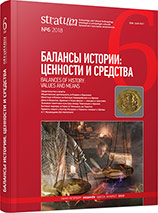Импортные кофейные чашечки из закрытого комплекса конца XVII века в Каменце-Подольском
Imported Coffee Cups from the Closed Complex of the End of the 17th Century from Kamianets-Podilskyi
Author(s): Irina R. Gusach, Pavlo NechytayloSubject(s): History, Archaeology, Cultural history, Modern Age, 17th Century
Published by: Издательский дом Stratum, Университет «Высшая антропологическая школа»
Keywords: Kamianets-Podilskyi; end of the 17th century; Polish market square; Podolya Eyalet (1672—1699); “closed” complex; coffee house; coffee cups; Chinese porcelain; Turkish and Persian faience
Summary/Abstract: The Kamianets-Podilskyi architectural and archaeological expedition of the Institute of Archaeology of the National Academy of Sciences of Ukraine conducted archaeological excavations on Polish market of the city of Kamianets-Podilskyi (Ukraine) in 2016. The eastern part of the dig contained remains of a building which, as it turned out, was used as a coffee house. This is confirmed by written sources — a detailed description of the city is given in “Defter-i mufassal”, made by the Ottomans in 1681. Also, this document mentions 10 coffee houses which existed in Kamianets-Podilskyi. Also, the fact is proved by archaeological finds — a large number of clay pipes (over 600 samples) and painted coffee cups made of porcelain, faience and clay (more than 100 samples). The bulk of the collection of cups are porcelain ones from Chinese provinces (50%) and faience products of Turkish ceramic centre of Kütahya (32%). A small number of cups (13%) are presumably attributed by the authors to the so-called “Persian faience”. Five cups (5%) are classified as clay glazed ware, probably of Minor Asia production. Prevalence of expensive eastern utensils among ceramics demonstrates prestige of the coffee house and, obviously, confirms a rather high social status of its visitors. The discovered archaeological object belongs among some rare “closed” contexts of the 17th century, which were discovered on the territory of the former Ottoman Empire. It is well-dated by coins and ceramic “markers”, as well as by certain types of Polish artillery shells.
Journal: Stratum plus. Археология и культурная антропология
- Issue Year: 2018
- Issue No: 6
- Page Range: 319-357
- Page Count: 39
- Language: Russian
- Content File-PDF

